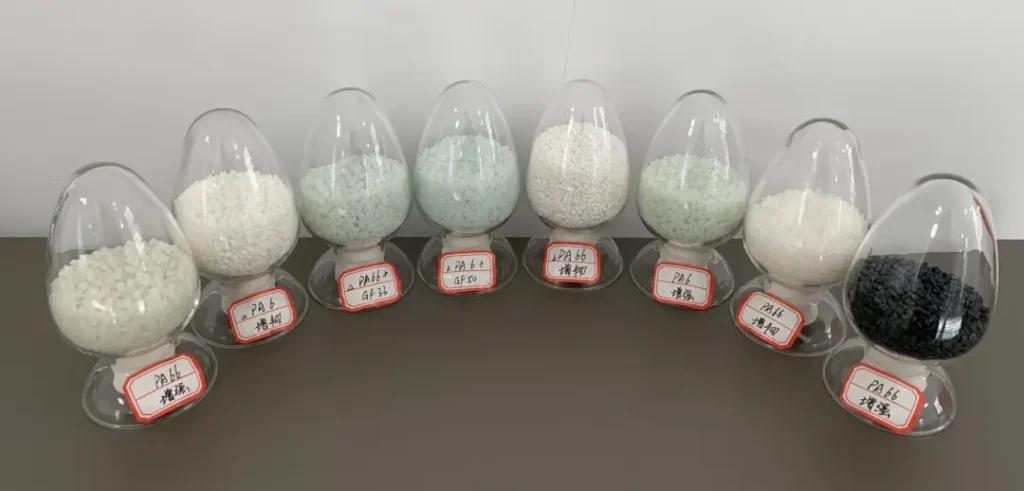Polyamidit, jotka tunnetaan yleisesti nimellä nailonit, ovat laaja ryhmä teknisiä kestomuoveja, joita arvostetaan niiden lujuuden, monipuolisuuden ja kemiallisen kestävyyden vuoksi. Tässä ryhmässä PA6 ja PA66 ovat kaksi merkittävää jäsentä, jotka voivat aiheuttaa sekaannusta samankaltaisten nimien ja yhteisen perusmateriaalin vuoksi. Tässä oppaassa perehdytään PA6:n ja PA66:n tärkeimpiin eroihin, jotta materiaali-insinöörit voivat tehdä tietoon perustuvia valintoja projekteissaan.
PA6 VS PA66 Samankaltaisuudet:
- Sekä PA6 että PA66 ovat vahvoja, kulutusta kestäviä kestomuoveja, joilla on hyvä kemiallinen kestävyys.
- Niitä käytetään laajalti autojen osissa, kulutustavaroissa ja erilaisissa teollisissa sovelluksissa.
PA6 (Polyamidi 6):
- Plussaa:Helpompi prosessoida alhaisemman sulamispisteen vuoksi, mikä johtaa mahdollisesti alhaisempiin valmistuskustannuksiin. Hyvä sitkeys ja iskunkestävyys. Parempi suorituskyky kosteudelle altistuvissa sovelluksissa paremman hydrolyyttisen stabiilisuuden ansiosta.
- Miinukset:Alhaisempi lämpötilankestävyys verrattuna PA66:een, minkä vuoksi se muotoutuu todennäköisemmin kovassa kuumuudessa. Suurempi kosteuden imeytyminen voi johtaa mittamuutoksiin.
PA66 (Polyamidi 6,6):
- Plussaa:Ylivoimainen lämpötilankestävyys ja mekaaninen lujuus, mikä tekee siitä ihanteellisen vaativiin sovelluksiin. Säilyttää hyvän suorituskyvyn korkeissa lämpötiloissa. Alhaisempi kosteuden imeytyminen voi edistää parempaa mittapysyvyyttä.
- Miinukset:Korkeamman sulamispisteen vuoksi haastavampi prosessoida, mikä saattaa nostaa valmistuskustannuksia. Kalliimpi kuin PA6.
Miten valita oikea materiaali:
- Korkean lämpötilan suorituskyky ja lujuus:PA66 on selvä voittaja.
- Käsittelyn helppous ja kustannukset:PA6 tarjoaa etua.
- Kosteudenkestävyys:PA6 saattaa olla parempi valinta hydrolyyttisen stabiilisuutensa vuoksi, mutta ota huomioon yleinen kosteuden imeytymistarve mittapysyvyyden kannalta.
PA6 VS PA66 Muita näkökohtia:
- Palonesto:Sekä PA6:n että PA66:n joihinkin muunnelmiin on saatavana palonestoaineita sovelluksen vaatimuksista riippuen.
- Kitkaominaisuudet:PA6 saattaa tarjota paremmat itsevoiteluominaisuudet tietyissä sovelluksissa kuin PA66.
- Väsymiskestävyys:PA66 osoittaa yleensä parempaa väsymiskestävyyttä syklisissä kuormitusolosuhteissa.
Optimaalisen materiaalin valinta PA6:n ja PA66:n välillä riippuu sovelluksen erityisvaatimuksista. Arvioi huolellisesti sellaiset tekijät kuin lämpötilankestävyys, käsittelytarpeet, kustannusrajoitukset, kosteusaltistus, syttyvyysvaatimukset, kitkakäyttäytyminen ja väsymiskestävyys. Ymmärtämällä PA6:n ja PA66:n erilaiset ominaisuudet materiaali-insinöörit voivat tehdä perusteltuja päätöksiä, jotka varmistavat projektien onnistumisen.

